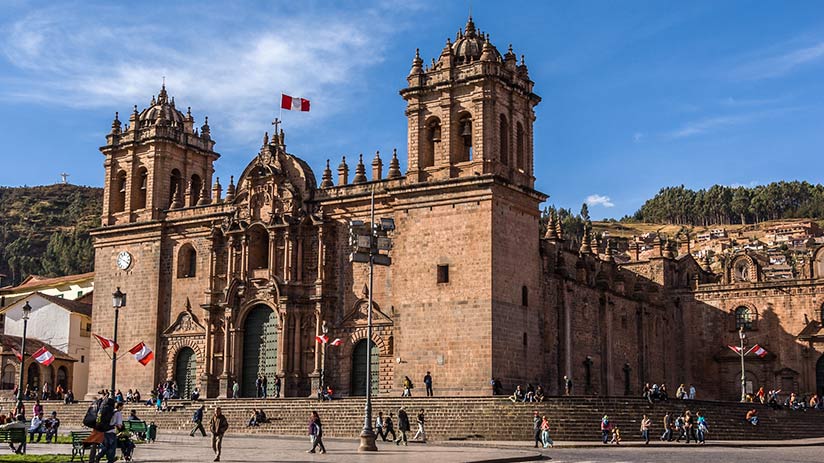Cusco is famous for Machu Picchu, Incas archaeological sites, and historic sites, you will find numerous attractions and historical buildings to tour and appreciate. Among its most essential constructions, you can find the Cusco Cathedral, one of the most iconic churches in the city. The magnificent Cathedral took built almost 100 years to complete. The Cusco Cathedral was built with stone blocks brought from the fortress of Sacsayhuaman. It is one of the most famous churches in America and Peru. That’s why together with the travel experts of Machu Travel Peru, we want to tell you about this iconic monument of the Imperial City.
All you need to know about the Cusco Cathedral
- Cusco Cathedral
- Cathedral location
- History of the Cusco Cathedral
- Cusco Cathedral architecture
- What to see in the Cusco Cathedral
- Escuela Cusqueña art style (Cusquenian School)
- How to visit the Cusco Cathedral
Cusco Cathedral
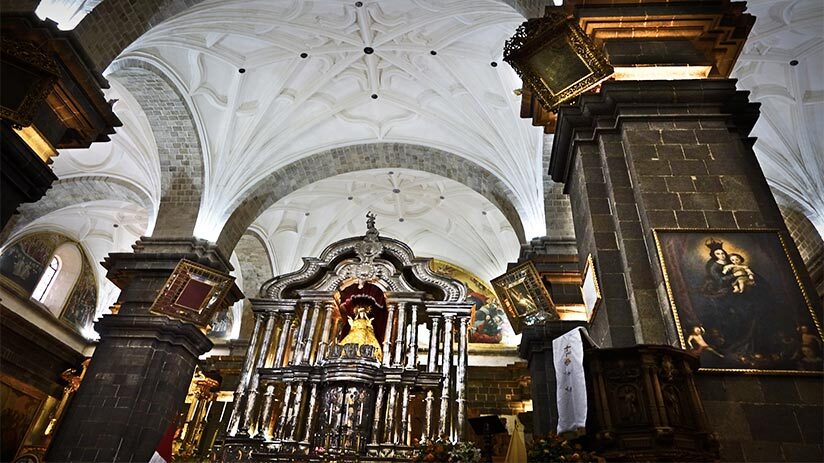
Cusco cathedral or Virgin Assumption Basilica is over an ancient Inca palace, inside Main Square, north side. It was built between 1559 and 1654, with 3,918 square meters. It has 14 pillars supporting 24 snowy arch roofs and is a beautiful example of Renaissance, Baroque and Gothic styles.
Overview
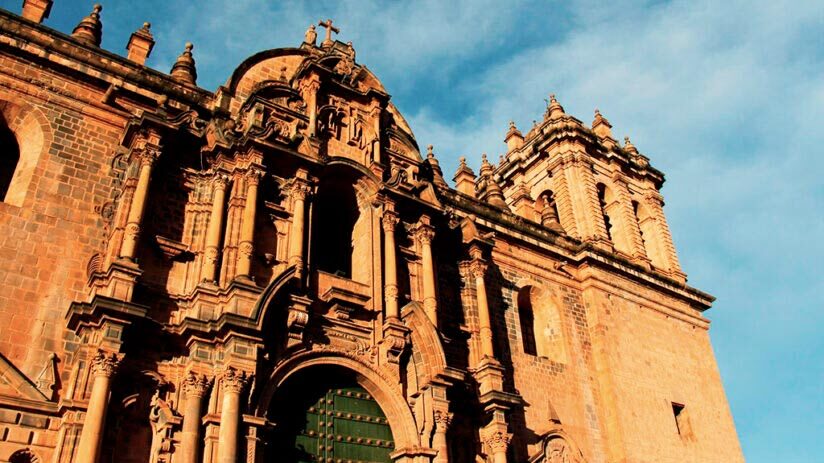
The Cusco Cathedral is one of the most emblematic buildings of the ancient capital of the Inca Empire. Besides, it is one of the main attractions to appreciate on a walking tour in Cusco. This historical construction is also considered a Cultural Heritage of the Nation and has a combination of unique characteristics. The Cusco Cathedral is important by its Gothic, Baroque, and Renaissance styles that blend harmoniously, unique in South America. Also, by its largest deposits of colonial art representative of Cusquenian school style. The entire Cathedral houses an innumerable amount of artworks from the Cusco art school. Valuable examples of art that are worth knowing and admiring.
Cathedral location
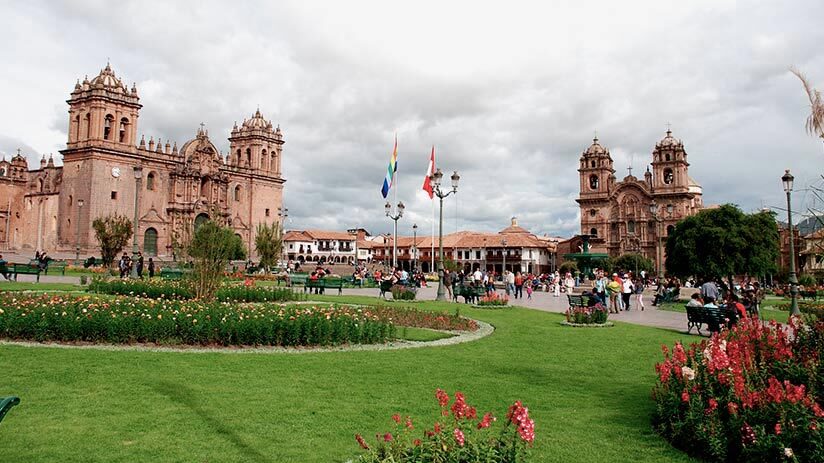
The Cathedral of Cusco is located in the southeastern center of Peru. More specifically, in the beautiful imperial city of Cusco, in front of the iconic Plaza de Armas. It was built on Quishuarcancha, the ancient palace of the Inca Viracocha. Its amazing architecture is renowned as the Cathedral Basilica of the Assumption of the Virgin by the locals. Today it is a UNESCO World Heritage Site, and it is worth visiting. Inside you will find important archaeological relics, statues, artifacts, and hundreds of colonial paintings.
History of the Cusco Cathedral
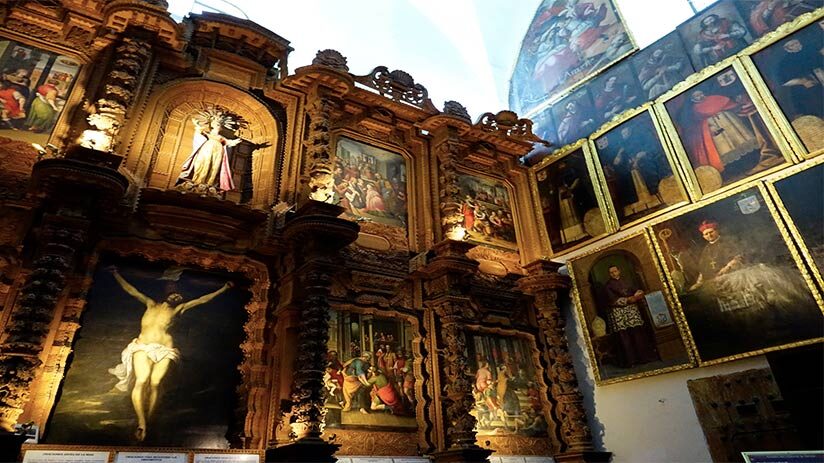
The history of the Cusco Cathedral begins in the year 1534 when it was decided to undertake its edification. The construction lasted around one century and more than 5 architects passed by its administration. First, it was decided to start construction where the Iglesia del Triunfo is now located, the initial cathedral of Cusco (Therefore, this is considered among the group of old churches in Cusco) But after, it was decided to build it in the Cusipata area (current Regocijo Square) thanks to its size. But the land of Quishuarcancha, ancient Inca Viracocha residential, was finally acquired in 1553, where today it is imposingly situated.
The first architect in charge of the work was the Spanish named Juan Miguel de Veramendi, under the tutelage of the first Archbishop of Cusco, Vicente Valverde (promoter of its construction). He ordered to use the stones of Sacsayhuaman Archaeological park for the construction of the church. In this form, the amazing Inca site was destroyed and looted. Unfortunately, it was the natives themselves who formed the main workforce for construction. Many of them died during the process, crushed by the rocks that fell from the top of Sacsayhuaman. Therefore, it wasn’t until 1668 that the construction was completed.
The reasons for the construction of the Cusco Cathedral were not always benevolent. Since there was a clear intention to impose European Christianity over the Andean religion. In this way, the meaning of the Cathedral, built on the foundations of an ancient Inca temple called Quishuarcancha (ancient palace of the Viracocha, a 15th-century Inca emperor), was a clear message for the native people. Consequently, the Spanish conquerors forced the Inca people to build the cathedral over this palace and to adopt the Catholic religion.
Bell tower of Maria Angola
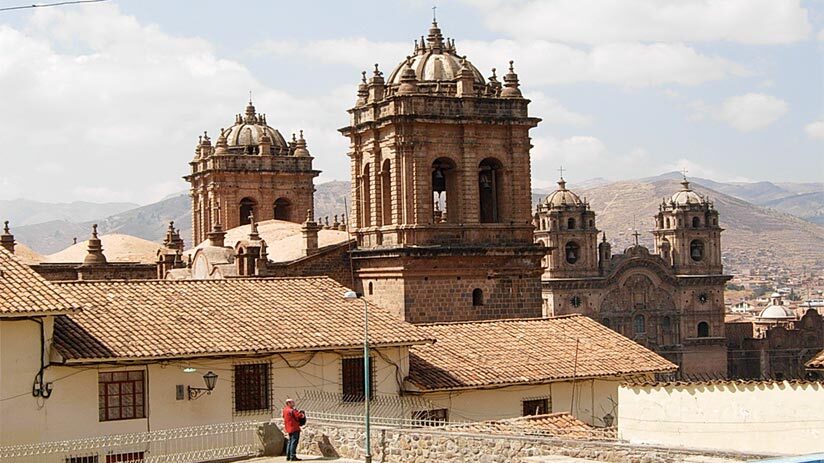
There is no doubt that the Cathedral of Cusco covers an extensive history full of mystical overtones. Its bell is quite famous and is known as “La Maria Angola”. This has a size of 12.15 meters of altitude with 5980 kilograms of weight and the locals affirm that its sound can listen to more than 20 miles of distance. Currently, it is considered the best monumental bell in South America due to its dimensions and metallic vibration.
Legend has it that a very wealthy woman named Maria Angola lived in Cusco. She loved extremely to her husband. Therefore, when she became a widow, she decided to enter the cloistered convent of Santa Teresa, where she donated her fabulous jewelry to the construction of a new cathedral bell tower in 1655. In this form, it is said that its gems and jewels of it were melted among other wealthy Cusco families’ jewels to create the enormous bell of the church.
Cusco Cathedral architecture
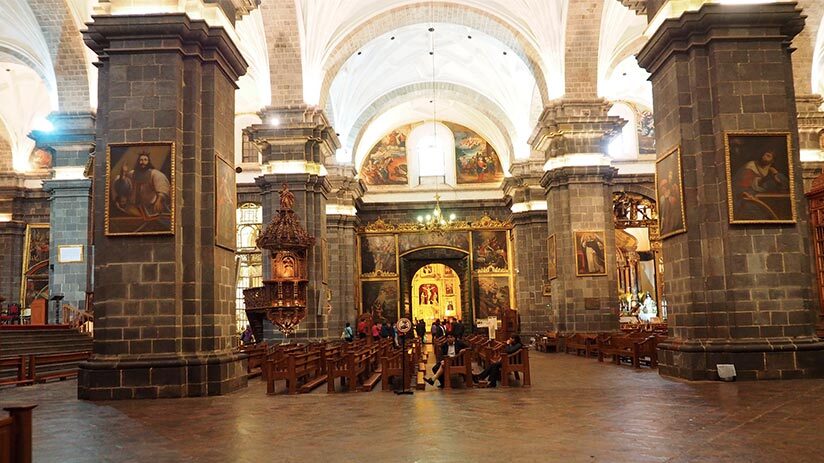
The Cusco Cathedral facade was designed in a Renaissance style, while its interior was built following forms and curves of Gothic-Baroque touches. The entire complex covers an area of 3,918 square meters. Also, the plans of the church were designed in the shape of a Latin cross. A revolutionary style inside South America during the period of its construction. Due to the time in which it was built, it has an evident influence of a Gothic-Renaissance style that the great Spanish cathedrals used to have. You can even see some touches of Baroque style in its monumental towers and other parts of its facade.
The Cusco Cathedral has a rectangular shape with three large wooden doors on its facade. The main structure has 14 pillars, all in the shape of crosses. These pillars support 24 roofs in the shape of a star or snowy arch. Many of the stones used in its construction belonged to the nearby Inca site of Sacsayhuaman. The central nave is oriented by the main altar, embossed in silver. While in the opposite it is situated the choir stalls. Besides, the cathedral has 14 side chapels that contain different works of art, statues of saints, virgins, and paintings. Therefore, the Cusco cathedral can be considered one of the most important museums in Cusco, too.
Next to the Cathedral, there are two auxiliary chapels: the Iglesia del Triunfo on the right side and the Sagrada Família on the left side. The Iglesia de la Sagrada Familia was built in 1723 and the Iglesia del Triunfo was built in 1536, and the last one was considered the Cathedral of Cusco until the construction of the modern one. Therefore, the most important structure in Cusco is many, not only one. Sacsayhuaman archaeological park, the Cathedral, the Coricancha, and Sun temple.
What To See In The Cusco Cathedral
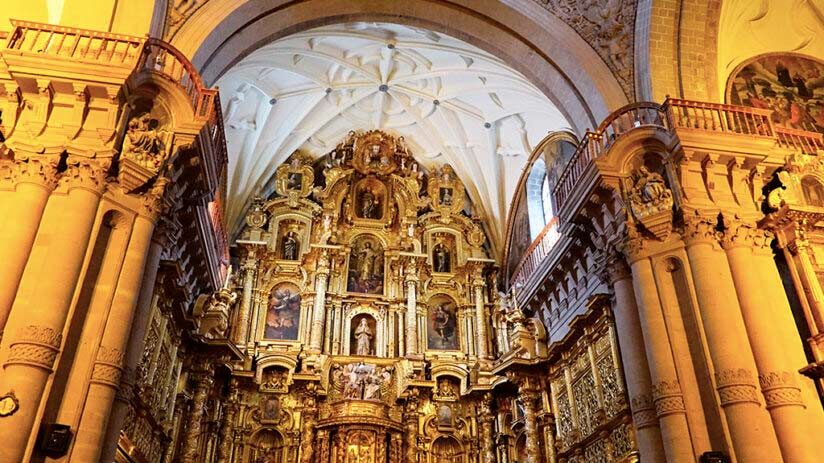
Fortunately, there is a lot to do at the Cusco Cathedral. Inside the Church, you can enjoy numerous art and architecture pieces with unique touches. But, don’t worry, on the majority of Cusco city tours, the visit to the Cathedral is an obligatory point to know the colonial age of Cusco and Peru.
The entire Cathedral of Cusco has splendid altars in the Renaissance, Baroque and Neoclassical styles.
- Under the right side of the main altar of the Basilica, there is a little arched crypt that contains the ashes of some deceased archbishops. Among them, you will find the little crypt of Vicente Valverde, the archbishop who promoted its construction, and Manuel Mollinedo y Angulo crypt, another archbishop who was the most famous protector of many painters, architects, and local sculptures, whose works of art adorn the Cathedral.
- 14 little chapels located in the side aisles (left and right) devoted to different saints surround the central nave of Cusco cathedral. There, you will find sculptures and paintings belonging to the “Escuela Cusqueña” local art style. The most ancient of them is a painting regarding of earthquake of 1650 in Cusco.
- There is also the Sala de la Plata (Silver salon), a small side chapel where you can see a collection of religious objects made of silver dating back more than one hundred years. For example, one of the most impressive elements in this room is the large dome-like trellis car. This one is framed in wood and covered with more than 160 kilograms of silver. Often it is taken for a walk around Plaza de Armas (Cusco main square) during Corpus Christi celebrations and features a silver pelican in its front.
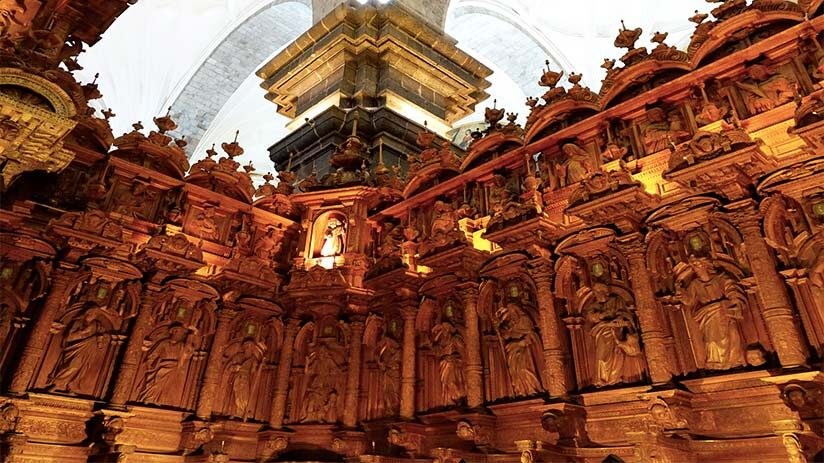
- Another of the must-see attractions of the Cusco Cathedral is the choir stalls, made entirely of pure cedar. This is located right in the lower central nave of the Cusco Cathedral and inside it, you will see the fine sculptures of all Cusco archbishops on cedarwood. There is located a Pampa Piano, a piano makeup based on air tubes with a particular sound.
- The altar of the statue of the Lord of the Earthquakes or “Señor de Los Temblores” is another of the most notable points in the church. It is said that for hundreds of years the smoke from the candles situated in front of him was what blackened his skin. He is the sworn patron of Cusco and the legend said that it was ordered to be sculpted by order of the King Phillip II of Spain in 1570, seeing that the indoctrination of the indigenous people in Peru to Catholicism had not been in effect. The statue was brought from Spain to Peru by sea. The ship had to suffer hurricanes and hard storms that were only appeased by taking the sculpture to the stern and, thus, sailing to Peru. Once in the Andean country, the statue was brought from Lima to Cusco, but other unforeseen happened along the way. On the pass of Mollepata (A town located west of Cusco), the entourage decided to rest for one day, when they reloaded the statue, it did not move from its site. Her weight had quintupled! In this form, after many tries, they decided to leave the statue there, obligating to Mollepata people to build a church around the immobile statue. The responsible for the transportation ordered an unknown Cusquenean artist, to sculpt another similar statue and, finally, this was brought to the Cathedral of Cusco. The statue was forgotten for many years until an earthquake in 1650 obligated the local people to put it under the facade of the Cathedral, miraculously the earthquake disappeared. In this same way, the statue helped to disappear an epidemic that occurred in 1720. Since this year, it was renamed the Lord of the Earthquakes.
Escuela Cusqueña art style (Cusquenian School)
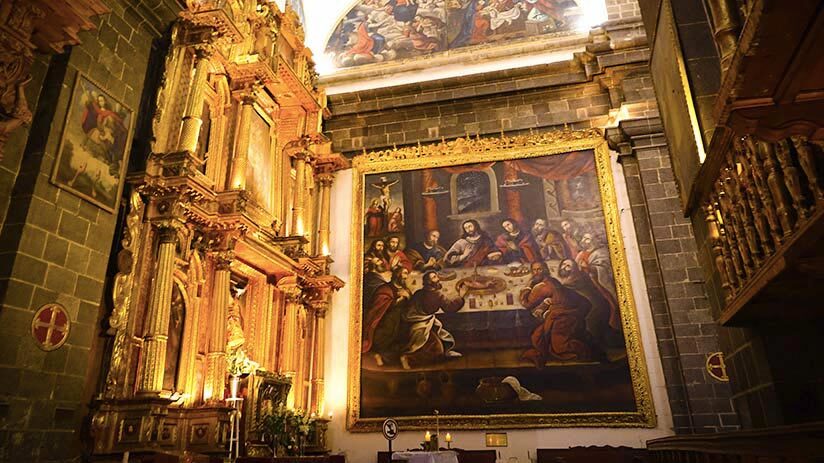
Last but not least, you can find a collection of canvases belonging to the Cusco school of art. This painting style combines the corresponding style to the devotional Europe of the seventeenth century, along with other symbolic techniques of Andean artists from Cusco. Its most famous representatives are local artist like Diego Quispe Tito, Basilio Santa Cruz Pumacallao, Basilio Pacheco, and Marcos Zapata. The latter was the creator of a particular “last supper” where the main dish is the traditional roasted guinea pig. European religious thematic combines with native food, landscapes, and objects.
Another important painting there is a representation of a virgin, whose skirt resembles an Andean mountain, its embroideries to rivers among other many characteristics. Some studies affirm that this virgin was a representation of Pachamama, the mother earth to the Incas people. Another example of the Cusquenean school art style.
Therefore, being able to tour the interiors of the Cathedral is one of the best things to do in Cusco. In addition, no tour of the city is complete without knowing this wonderful architectural work.
How to visit the Cusco Cathedral
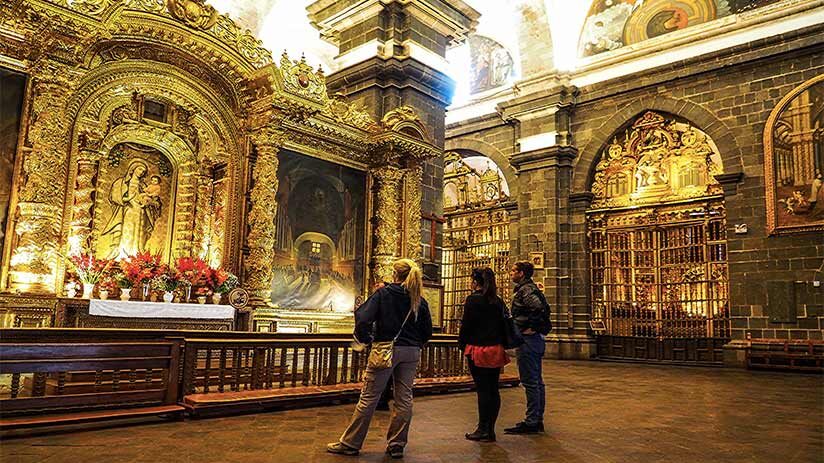
The Cusco Cathedral is found in the heart of the ancient capital of the Inca Empire. Both tourists and locals can enter the church using the entrance of the Iglesia del Triunfo (triumph) located just to the right of the facade of the cathedral. As you can see, the visit to the Cusco cathedral is a complete route that includes the Triumph Church, the same Cathedral, and the Sagrada Familia Church (Sacred family)
- In general, the Cathedral of Cusco is open seven days a week. And the available hours are from 10 AM to 5 PM.
- The entrance to the cathedral costs 40 Nuevos Soles, or approximately 11 US dollars per adult (From 18 years old to more)
- And 20 Nuevos soles per student (From 9 years old to 18). The students will have to show their passports or student card to buy the ticket.
- Children under 9 years old don’t pay for entrance and can enter free to the Cathedral, always accompanied by their parents.
- The purchase of entrance is direct and personal at the counter situated at the entrance of Triumph church (El Triunfo), showing a passport. At this moment, the sales personnel only accept cash, not credit cards.
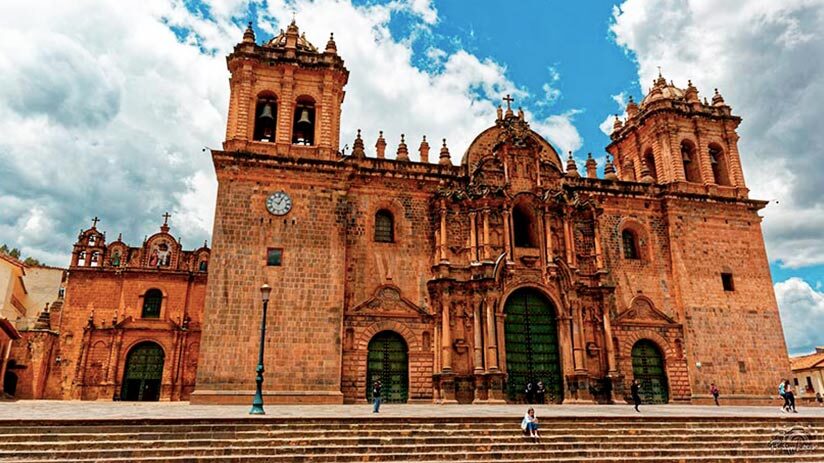
To get to the Cathedral of Cusco, you just have to go to the well-known Plaza de Armas. You can get to it through the Cusco main avenue known as Avenida Sol. The cathedral is located just on the north side of the square. It has a rectangular design and is one of the most predominant views of the Plaza de Armas. Without a doubt, one of the most beautiful and unprecedented churches on the Cusco tourist map.
“TO TRAVEL IS WORTH ANY COST OR SACRIFICE”
The Cusco Cathedral is a must for those looking to tour the beautiful Imperial City. It does not matter if you are exploring the city on your own or in a group, it is a must-see building. Especially if you are near the iconic Plaza de Armas. No visit to Cusco is complete without first touring its beautiful historic center. And a visit to the Cathedral of Cusco is a visit to the history of this cosmopolitan city. We hope together with the Machu Travel Peru team to have been helpful in your travel plans. If you want more information about our private tours of Cusco, you can consult with our qualified advisers. They will be happy to help you organize your dream trip!
